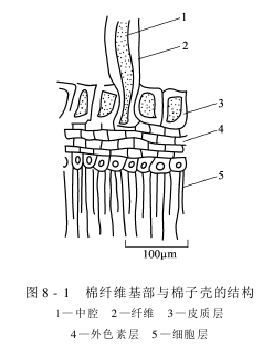Overview Ginning Mechanism
After the pre-treatment process, the cotton enters the ginning process. Ginning uses mechanical action to separate the long fibers growing on the cotton seeds from the cotton seeds to form lint, while retaining the short lint on the cotton seeds. The machine that separates cotton seeds and long fibers is called a gin.
1. Ginning mechanism
The basic task of the ginning process is to separate long fibers and cotton seeds. To achieve this goal, two conditions must be met, namely internal factors and external factors.
The internal reason for the difference between long fibers and cotton seeds is that the absolute strength of the cotton fiber itself must be greater than the fixation strength of the fiber on the cotton seeds. This depends on the physical properties of the cotton itself. Cotton fiber is extended from the epidermal cells of the seed, and its base is part of the epidermal cells of the cotton seed. As shown in Figure 8-1, it can be seen that the base of the cotton fiber is relatively weak, which is conducive to the separation of the fiber from the cotton seed epidermis. Therefore, during ginning, the upper part of the fiber base is easy to break. Experimental data also proves this. The fixing force of a single fiber on cotton is 40% to 60% of its own breaking strength, and the absolute strength of a bundle of fibers is 12 to 15 times the fixing strength. The internal condition of cotton fiber is a necessary condition for the separation of fiber and cotton seed, and is also the basic principle guiding ginning work.

Zi Mian The fixing power of fibers has a great relationship with the degree of dryness. The fiber strength and fixing power of moist cotton are higher than that of dry cotton. The fixing force of fibers on cotton seeds Figure 8-1 The structure of cotton fiber base and cotton seed shell is also related to its location. The fixing force of cotton seeds tips is greater than the fixing force of cotton seeds middle part. Therefore, the fibers at the tip are generally not easy to roll off. The blunt end (chaleal end) of cotton seeds has a thin shell, and the cohesion of cotton fibers is small. The fibers at the blunt end are easy to separate from the cotton seeds during ginning, but the shells are easily broken, resulting in cracks and fiber scraps.
The external conditions for the separation of long fibers and cottonseeds are that there must be mechanical action, so that the fibers and cottonseeds are acted upon by external forces at the same time, and the resultant force of these external forces acting on the fiber base of the cottonseed epidermis is greater than the fiber (1) the cottonseeds are blocked At the same time, the fibers are pulled by external forces.
(2) The fibers and cotton seeds are relaxed under the action of external forces at the same time. Due to the different size and direction of the external force and the quality of the fibers and cotton seeds, the speed difference between the two creates a relative relaxation, causing the cotton fibers and cotton seeds to separate.
(3) While the fibers are pulled by external force, the cotton seeds are impacted by external force in the other direction.
AAAFGNHIYIYO







